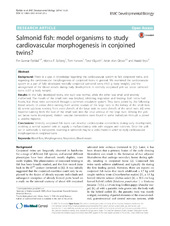Salmonid fish: model organisms to study cardiovascular morphogenesis in conjoined twins?
Fjelldal, Per Gunnar; Solberg, Monica F.; Hansen, Tom; Vågseth, Tone; Glover, Kevin Alan; Kryvi, Harald
Peer reviewed, Journal article
Published version
Permanent lenke
http://hdl.handle.net/1956/12540Utgivelsesdato
2016-07-16Metadata
Vis full innførselSamlinger
Originalversjon
https://doi.org/10.1186/s12861-016-0125-xSammendrag
Background: There is a gap in knowledge regarding the cardiovascular system in fish conjoined twins, and regarding the cardiovascular morphogenesis of conjoined twins in general. We examined the cardiovascular system in a pair of fully developed ventrally conjoined salmonid twins (45.5 g body weight), and the arrangement of the blood vessels during early development in ventrally conjoined yolk sac larvae salmonid twins (<0.5 g body weight). Results: In the fully developed twins, one twin was normal, while the other was small and severely malformed. The mouth of the small twin was blocked, inhibiting respiration and feeding. Both twins had hearts, but these were connected through a common circulatory system. They were joined by the following blood vessels: (i) arteria iliaca running from arteria caudalis of the large twin to the kidney of the small twin; (ii) arteria subclavia running from aorta dorsalis of the large twin to aorta dorsalis of the small twin; (iii) vena hepatica running from the liver of the small twin into the sinus venosus of the large twin. Among the yolk sac larvae twins investigated, distinct vascular connections were found in some individuals through a joined v. vitellina hepatica. Conclusions: Ventrally conjoined fish twins can develop cardiovascular connections during early development, enabling a normal superior twin to supply a malfunctioning twin with oxygen and nutrients. Since the yolk sac in salmonids is transparent, twinning in salmonids may be a useful model in which to study cardiovascular morphogenesis in conjoined twins.

